Infection in the lining of the stomach. Gastritis: Understanding H. pylori Infection, Symptoms, and Treatment Options
What is Helicobacter pylori. How does H. pylori affect stomach lining. What are the risk factors for H. pylori infection. What symptoms indicate possible H. pylori infection. How is H. pylori diagnosed and treated.
Understanding H. pylori: The Bacteria Behind Gastritis
Helicobacter pylori, commonly known as H. pylori, is a type of bacteria that infects the stomach lining. This microscopic organism can cause significant damage to the stomach and duodenum, leading to inflammation, ulcers, and other digestive issues. H. pylori is remarkably common, with a large portion of the global population harboring the bacteria, often without showing any symptoms.
The bacteria’s ability to survive in the harsh acidic environment of the stomach is due to its unique adaptations. H. pylori produces an enzyme called urease, which neutralizes stomach acid in its immediate vicinity. This weakens the protective mucus layer of the stomach, making it more susceptible to damage from digestive fluids.

How H. pylori Affects the Stomach
H. pylori’s impact on the stomach is multifaceted:
- It attaches to the stomach lining, causing inflammation
- The bacteria can stimulate increased acid production
- It weakens the stomach’s natural defenses against acid
- In some cases, it leads to the formation of ulcers
While many people with H. pylori remain asymptomatic, the bacteria is a primary cause of peptic ulcers and chronic gastritis.
Transmission and Risk Factors for H. pylori Infection
The exact transmission route of H. pylori remains a subject of ongoing research. However, experts believe that the bacteria can spread through several means:
- Person-to-person contact, particularly through saliva
- Exposure to contaminated food or water
- Contact with infected fecal matter
Certain factors may increase an individual’s risk of H. pylori infection:
Age as a Risk Factor
Age plays a significant role in H. pylori prevalence. In the United States, over half of the individuals infected with H. pylori are over 50 years old. This higher prevalence in older adults may be due to cumulative exposure over time or changes in hygiene practices across generations.

Ethnic and Geographic Considerations
Ethnicity and geographical origin also influence H. pylori infection rates. For instance:
- Nearly half of African Americans harbor the bacteria
- At least 50% of Latinos and Eastern Europeans who immigrate to the U.S. have H. pylori
- Infection rates are generally higher in developing countries
These disparities may be attributed to variations in living conditions, sanitation practices, and access to healthcare across different populations.
Recognizing the Symptoms of H. pylori Infection
H. pylori infection often remains asymptomatic for years. However, when symptoms do manifest, they can include:
Gastritis Symptoms
Gastritis, or inflammation of the stomach lining, is a common result of H. pylori infection. Symptoms may include:
- Nausea
- Vomiting
- Loss of appetite
- Bloating
- Indigestion
Peptic Ulcer Symptoms
When H. pylori leads to peptic ulcers, additional symptoms may emerge:
- Abdominal pain, often described as a dull ache
- Pain that occurs 2-3 hours after eating
- Night-time stomach pain
- Pain that comes and goes over several weeks
- Temporary relief from pain when eating or taking antacids
Other potential symptoms of ulcers include:

- Unexplained weight loss
- Appetite changes
- Nausea or vomiting
- Dark or tar-like stools (indicating potential bleeding in the digestive tract)
Diagnostic Approaches for H. pylori Infection
Accurate diagnosis of H. pylori infection is crucial for effective treatment. Healthcare providers employ various diagnostic methods to detect the presence of the bacteria:
Non-Invasive Tests
Several non-invasive tests can detect H. pylori infection:
- Blood tests: These detect antibodies produced in response to H. pylori infection
- Stool tests: These look for H. pylori antigens in a stool sample
- Urea breath test: This involves ingesting a urea pill containing carbon molecules and then testing for carbon in exhaled breath, indicating the presence of H. pylori’s urease enzyme
Invasive Diagnostic Procedures
In some cases, more invasive procedures may be necessary:
- Upper endoscopy (EGD): This procedure allows direct visualization of the stomach lining and collection of tissue samples for biopsy
- Biopsy: Tissue samples can be tested for the presence of H. pylori and the urease enzyme
The choice of diagnostic method depends on various factors, including the patient’s age, symptoms, and overall health status.

Treatment Strategies for H. pylori Infection
Treatment for H. pylori infection typically involves a combination of medications aimed at eradicating the bacteria and managing symptoms. The standard approach often includes:
Antibiotic Therapy
Antibiotics are the cornerstone of H. pylori treatment. Commonly prescribed antibiotics include:
- Clarithromycin
- Amoxicillin
- Metronidazole
Usually, a combination of two antibiotics is used to prevent antibiotic resistance.
Acid-Suppressing Medications
To complement antibiotic therapy and promote healing, acid-suppressing medications are often prescribed:
- Proton pump inhibitors (PPIs): These reduce acid production in the stomach
- H2-blockers: These also decrease stomach acid production
Bismuth Subsalicylate
In some cases, bismuth subsalicylate (Pepto-Bismol) may be added to the treatment regimen. This medication can help protect the stomach lining and has some antibacterial properties.
Treatment duration typically lasts 10-14 days, and follow-up testing is often recommended to ensure the infection has been successfully eradicated.
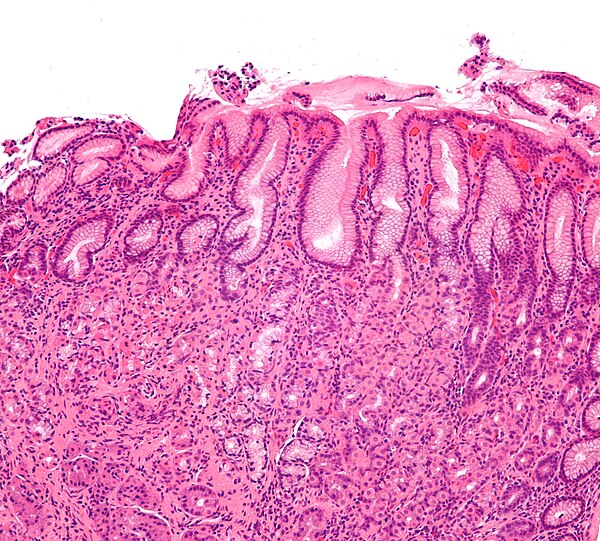
Preventing H. pylori Infection: Hygiene and Lifestyle Measures
While H. pylori infection is common, there are steps individuals can take to reduce their risk of contracting or spreading the bacteria:
Personal Hygiene Practices
- Wash hands thoroughly with soap and water, especially before eating and after using the bathroom
- Avoid sharing utensils, cups, or other personal items that come into contact with saliva
Food and Water Safety
- Consume clean, safe drinking water
- Properly wash fruits and vegetables before consumption
- Ensure food is cooked thoroughly, especially in areas with high H. pylori prevalence
Living Conditions and Sanitation
- Maintain clean living spaces
- Ensure proper sewage systems and waste management
- Avoid overcrowded living conditions when possible
While these measures can help reduce the risk of H. pylori infection, it’s important to note that complete prevention may not always be possible due to the bacteria’s prevalence and complex transmission routes.
Long-Term Implications of H. pylori Infection
Understanding the potential long-term consequences of H. pylori infection is crucial for both patients and healthcare providers. While many individuals with H. pylori remain asymptomatic, untreated infections can lead to various complications:

Chronic Gastritis
Persistent H. pylori infection can result in chronic inflammation of the stomach lining. This ongoing irritation may lead to:
- Persistent digestive discomfort
- Increased risk of developing peptic ulcers
- Potential interference with nutrient absorption
Peptic Ulcer Disease
H. pylori is a primary cause of peptic ulcers, which can develop in the stomach or duodenum. If left untreated, these ulcers may lead to:
- Chronic pain and discomfort
- Bleeding in the digestive tract
- Perforation of the stomach or intestinal wall
Gastric Cancer Risk
Long-term H. pylori infection has been associated with an increased risk of gastric cancer. While the absolute risk remains relatively low, certain factors may contribute to higher susceptibility:
- Genetic predisposition
- Dietary factors
- Duration and severity of infection
Regular monitoring and prompt treatment of H. pylori infection can help mitigate these long-term risks.
Emerging Research and Future Directions in H. pylori Management
The field of H. pylori research continues to evolve, with ongoing studies exploring new aspects of the bacteria’s biology, transmission, and treatment. Some areas of current interest include:

Antibiotic Resistance
As antibiotic resistance becomes a growing concern worldwide, researchers are investigating:
- Novel antibiotic combinations to combat resistant strains
- Alternative treatment strategies, such as phage therapy
- Methods to predict and prevent antibiotic resistance in H. pylori
Vaccine Development
Efforts to develop an effective vaccine against H. pylori are ongoing. Potential benefits of a successful vaccine include:
- Prevention of initial infection
- Reduction in reinfection rates
- Potential for large-scale prevention programs, especially in high-prevalence areas
Microbiome Interactions
Researchers are exploring the complex relationship between H. pylori and the human gut microbiome. This includes investigating:
- How H. pylori affects the overall composition of gut bacteria
- Potential protective effects of certain microbiome configurations against H. pylori infection
- The role of probiotics in managing H. pylori and its associated conditions
These ongoing research efforts hold promise for improving our understanding of H. pylori and developing more effective strategies for prevention, diagnosis, and treatment in the future.

Living with H. pylori: Management and Quality of Life
For individuals diagnosed with H. pylori infection, proper management is key to maintaining a good quality of life. While eradication of the bacteria is the primary goal, there are several strategies that can help manage symptoms and promote overall digestive health:
Dietary Considerations
Certain dietary habits may help alleviate symptoms associated with H. pylori infection:
- Avoid foods that trigger discomfort, such as spicy or acidic foods
- Eat smaller, more frequent meals to reduce stomach acid production
- Stay hydrated with water and non-caffeinated beverages
- Consider incorporating probiotic-rich foods or supplements, which may support digestive health
Lifestyle Modifications
Adopting certain lifestyle changes can complement medical treatment and improve overall well-being:
- Quit smoking, as it can exacerbate digestive issues and increase ulcer risk
- Limit alcohol consumption, which can irritate the stomach lining
- Manage stress through relaxation techniques, as stress may worsen symptoms
- Maintain a healthy weight to reduce pressure on the digestive system
Regular Medical Follow-up
Ongoing communication with healthcare providers is crucial for effective management:
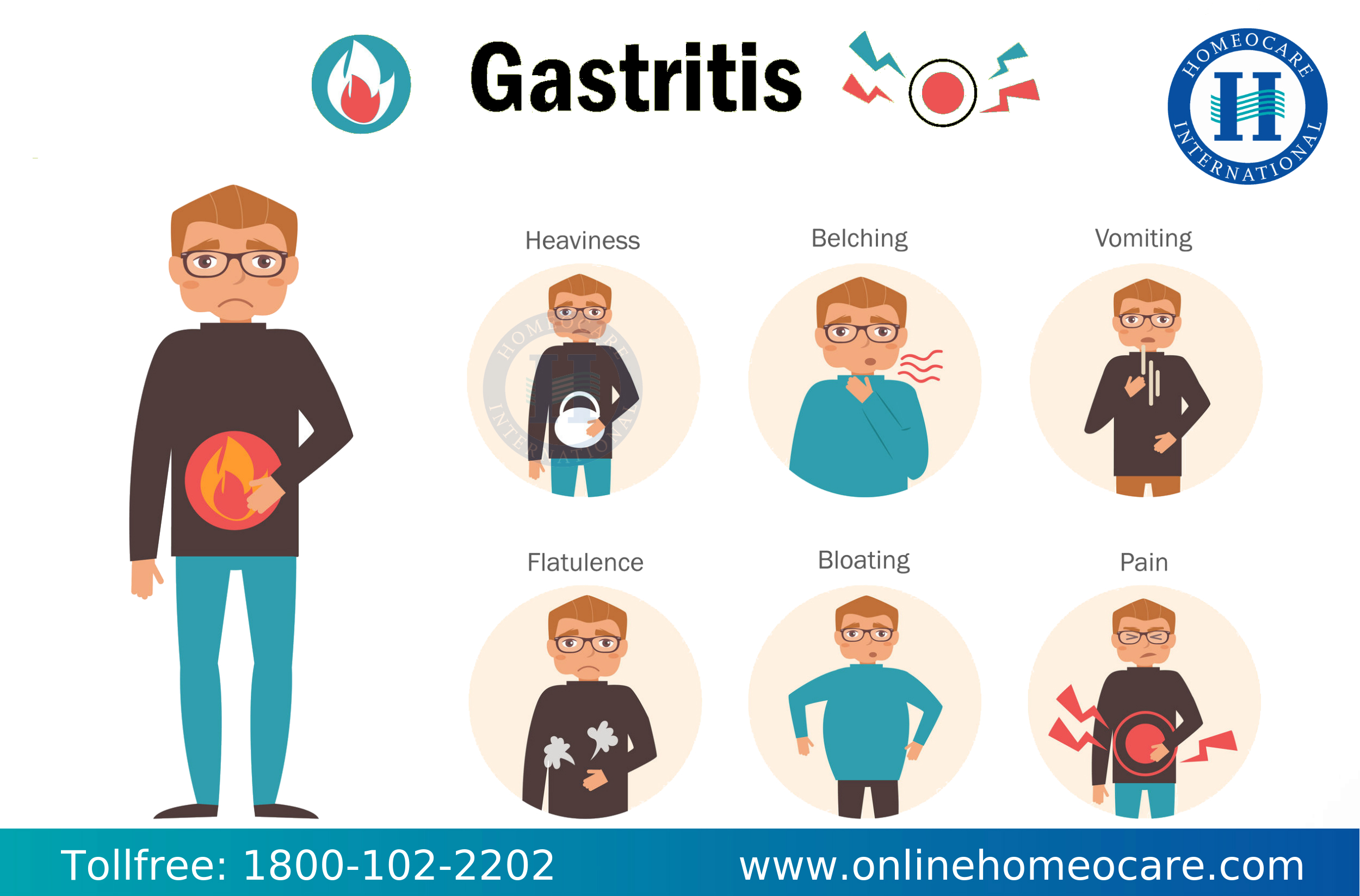
- Attend scheduled follow-up appointments to monitor treatment progress
- Report any persistent or new symptoms promptly
- Discuss any concerns or questions about medications or side effects
- Consider periodic testing to ensure successful eradication of H. pylori
By combining appropriate medical treatment with lifestyle modifications and regular healthcare monitoring, individuals with H. pylori can effectively manage their condition and maintain a good quality of life.
Helicobacter Pylori | Johns Hopkins Medicine
What is H. pylori (Helicobacter pylori)?
H. pylori (Heliobacter pylori, pronounced Hel-ee-koh-BAK-ter Pie-LORE-ee) is a type of bacteria that infects your stomach.
It can damage the tissue in your stomach and the first part of your small intestine (the duodenum). This can cause redness and soreness (inflammation). In some cases it can also cause painful sores called peptic ulcers in your upper digestive tract.
H. pylori is common. Many people have it. Most people who have it won’t get ulcers or show any symptoms. But it is a main cause of ulcers.
H. pylori attacks the lining that protects your stomach. The bacteria makes an enzyme called urease. This enzyme makes your stomach acids less acidic (neutralizes them). This weakens your stomach’s lining.
Your stomach cells then have greater risk of being hurt by acid and pepsin, strong digestive fluids. That can lead to sores or ulcers in your stomach or duodenum.
The H. pylori bacteria can also stick to stomach cells. Your stomach can’t protect itself very well. The area gets red and swollen (inflamed).
H. pylori can also get the stomach to make more acid. Health experts don’t fully understand how.
What causes H. pylori infection?
Health experts don’t know for sure how H. pylori infection is spread. They believe the germs can be passed from person to person by mouth, such as by kissing.
It may also be passed by having contact with vomit or stool. This may happen if you:
Who is at risk for H. pylori infection?
You may be at greater risk for H. pylori infection because of:
Your age. Over half the people in the U.S. with the bacteria are over 50 years old.
Your race or ethnicity. Almost half of all African Americans have the bacteria. For people who come to the U.S. from developing countries, at least 50% of Latinos and 50% of people from Eastern Europe have H.
 pylori.
pylori.
Most people first get the bacteria when they are children, but adults can get it too.
What are the symptoms of H. pylori?
Most people have the bacteria for years without knowing it because they don’t have any symptoms. Experts don’t know why.
You may have redness and swelling (inflammation) in your stomach lining. This is called gastritis.
You may get sores or peptic ulcers in your stomach or the first part of your small intestine (duodenum). Ulcer symptoms may include belly or abdominal pain, which can:
Be a dull pain that doesn’t go away
Happen 2 to 3 hours after you eat
Come and go for several days or weeks
Happen in the middle of the night when your stomach is empty
Go away when you eat or take medicines that reduce your stomach acid level (antacids)
Other symptoms of an ulcer may include:
The symptoms of ulcers may look like other health problems.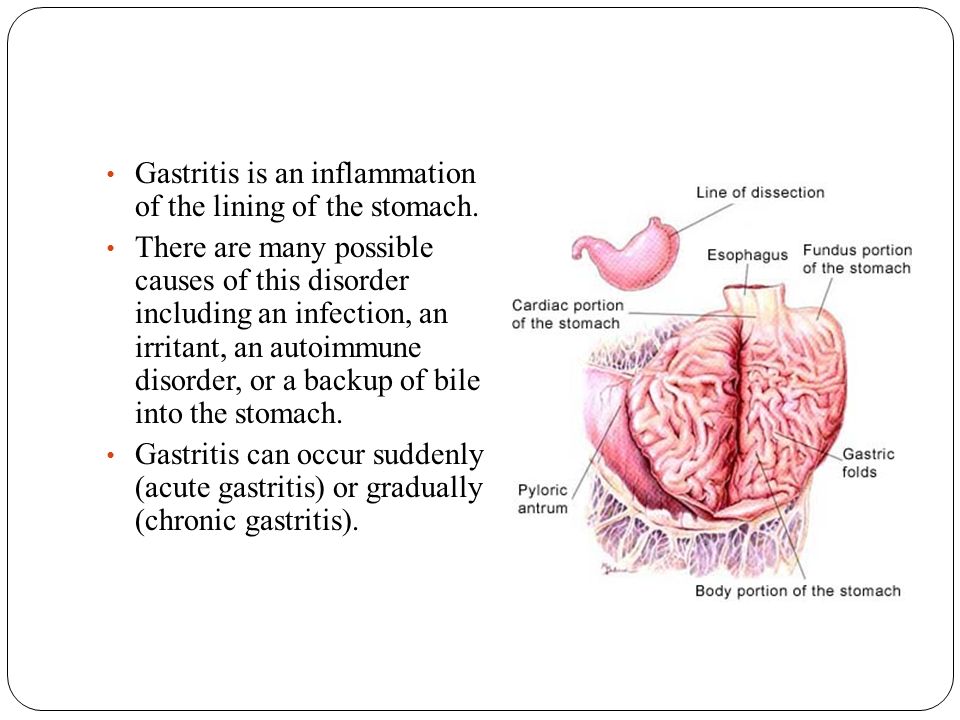 Always see your healthcare provider to be sure.
Always see your healthcare provider to be sure.
How is H. pylori diagnosed?
Your healthcare provider will look at your past health and give you a physical exam. He or she may also use other tests, including:
Blood tests. These check for infection-fighting cells (antibodies) that mean you have the bacteria.
Stool culture. This looks for any abnormal bacteria in your digestive tract that may cause diarrhea and other problems. A small stool sample is collected and sent to a lab. In 2 or 3 days, the test will show if you have any abnormal bacteria.
Breath tests. These can check if there is any carbon after you swallow a urea pill that has carbon molecules. If carbon is found that means that H. pylori has made the enzyme urease. This enzyme makes your stomach acids less acidic (neutralizes them). It weakens your stomach’s mucous lining.
Upper endoscopy, also called EGD (esophagogastroduodenoscopy).
 This test looks at the lining of your food pipe (esophagus), stomach, and duodenum (the first part of your small intestine). It uses a thin, lighted tube or endoscope. The tube has a camera at one end. The tube is put into your mouth and throat. Then it goes down into your esophagus, stomach, and duodenum. Your healthcare provider can see the inside of these organs. A small tissue sample (biopsy) is taken if needed. The tissue sample can show if you have the enzyme urease. It can also check the bacteria that is there.
This test looks at the lining of your food pipe (esophagus), stomach, and duodenum (the first part of your small intestine). It uses a thin, lighted tube or endoscope. The tube has a camera at one end. The tube is put into your mouth and throat. Then it goes down into your esophagus, stomach, and duodenum. Your healthcare provider can see the inside of these organs. A small tissue sample (biopsy) is taken if needed. The tissue sample can show if you have the enzyme urease. It can also check the bacteria that is there.
How is H. pylori treated?
Your healthcare provider will create a care plan for you based on:
Your age, overall health, and past health
How serious your case is
How well you handle certain medicines, treatments, or therapies
If your condition is expected to get worse
What you would like to do
Your healthcare provider may have you take medicine that kills bacteria (antibiotics).
Other medicines may include:
h3-blockers. These are used to reduce the amount of acid in your stomach by blocking the hormone histamine. Histamine helps to make acid.
Proton pump inhibitors. These help to keep your stomach from making acid. They do this by stopping the stomach’s acid pump from working.
Stomach-lining protectors. These medicines protect your stomach lining from acid and help kill bacteria.
Helicobacter Pylori in Children
H. pylori is a very common cause of peptic ulcers and gastritis in adults, but it can and does occur in children too.
Call your pediatrician if your child has any symptoms suggestive of gastritis. If your child has been diagnosed with an ulcer or H. pylori gastritis, call a doctor immediately if the following occur as they may be symptoms of gastrointestinal bleeding or ulcer perforation:
Sudden, sharp abdominal pain
Blood in the stool or black feces
Bloody vomit or vomit that looks like coffee grounds
What are the complications of H.
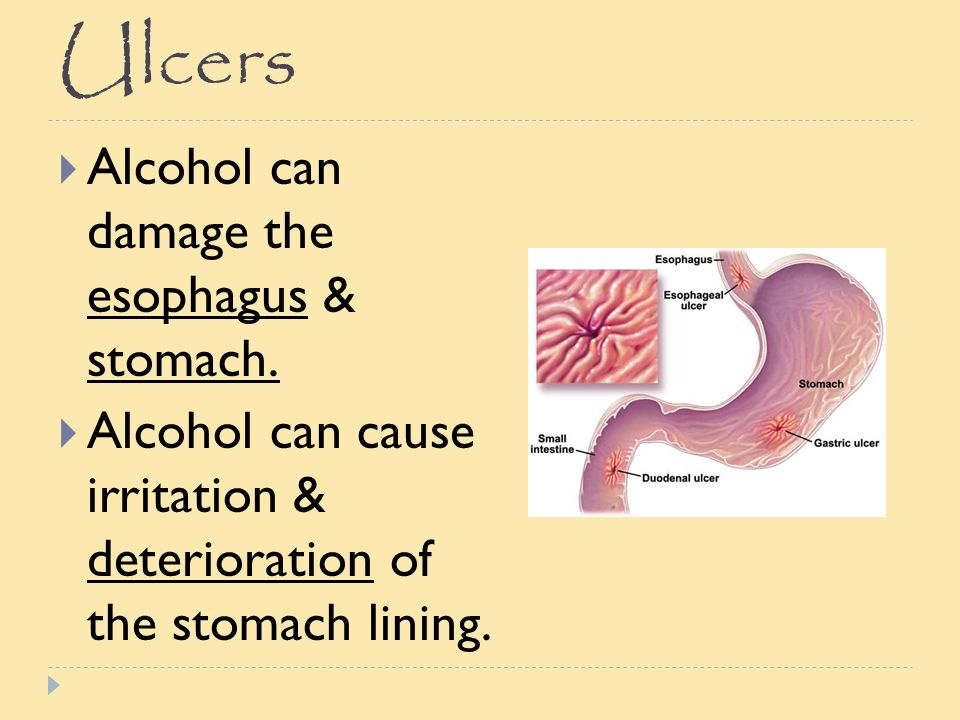 pylori?
pylori?
If you are infected with the bacteria you can get a painful sore called a peptic ulcer. These sores form in your upper digestive tract.
A very bad ulcer can wear away your stomach lining. It can also cause problems such as:
Bleeding when a blood vessel is worn away
A hole or perforation in your stomach wall
Blockage when the ulcer is in a spot that blocks food from leaving your stomach
H. pylori can also lead to stomach cancer.
What can I do to prevent H. pylori?
Health experts don’t know for sure how the bacteria passes from person to person. But having good health habits (hygiene) can help keep you safe. These habits include:
Washing your hands with soap and water. It is very important to do this after using the bathroom and before eating.
Making sure all food you eat has been cleaned and cooked safely
Making sure that your drinking water is safe and clean
Living with H.
 pylori
pylori
Once you know for sure that you have H. pylori, follow up with your healthcare provider. He or she will do some tests to make sure the bacteria has been removed.
When should I call my healthcare provider?
Call your healthcare provider if your symptoms get worse or you have new symptoms. Call right away if you have symptoms such as bloody vomit, blood in your stools, or black, tarry-looking stools.
Key points
H. pylori is a type of bacteria that infects your stomach.
It attacks your stomach and the first part of your small intestine (duodenum). This can cause redness and swelling (inflammation).
Many people with the bacteria won’t have any symptoms.
It can cause open sores called peptic ulcers in your upper digestive tract.
It can cause stomach cancer.
It may be passed or spread from person to person by mouth, such as by kissing.
 It may also be passed by direct contact with vomit or stool.
It may also be passed by direct contact with vomit or stool.Having good health habits (hygiene) can help protect you.
Next steps
Tips to help you get the most from a visit to your healthcare provider:
Before your visit, write down questions you want answered.
Bring someone with you to help you ask questions and remember what your provider tells you.
At the visit, write down the names of new medicines, treatments, or tests, and any new instructions your provider gives you.
If you have a follow-up appointment, write down the date, time, and purpose for that visit.
Know how you can contact your provider if you have questions.
Gastritis – Better Health Channel
Summary
Read the full fact sheet
- Gastritis is inflammation (irritation) of the stomach lining.

- Common causes include infection, anti-inflammatory medication and alcohol.
- Treatment options include avoiding exposure to known irritants, and medication to reduce the amount of gastric juices.
Gastritis is inflammation (irritation) of the stomach lining. This may be caused by many factors including infection, alcohol, particular medications and some allergic and immune conditions. Gastritis can be either acute (with severe attacks lasting a day or two) or chronic (with long-term appetite loss or nausea). In many cases, gastritis has no symptoms (asymptomatic).
Some forms, including chronic atrophic gastritis, have been associated with an increased risk of stomach cancer. Treatment options include avoiding exposure to known irritants and taking medication to reduce the amount of gastric juices.
Symptoms of gastritis
In many cases, gastritis has no symptoms. Common symptoms can include:
- loss of appetite
- pain in the upper abdomen just under the ribs
- nausea or indigestion
- hiccups
- vomiting
- blood in the vomit
- blood in the bowel actions, if the stomach lining has ulcerated (this turns stools black and is called melaena)
- weight loss.

The stomach
The stomach is an organ of the digestive system, located in the abdomen just below the ribs. Swallowed food is mixed with gastric juices containing enzymes and hydrochloric acid. The lining of the stomach, called the epithelium, is layered with multiple folds. The epithelium is coated with mucus (gastric mucosa) secreted by special glands. Inflammation caused by gastritis occurs in this lining.
Causes of gastritis
Gastritis can be caused by many different factors, including:
- medication such as aspirin and non-steroidal anti-inflammatory drugs (NSAIDS)
- infection with the Helicobacter pylori bacteria, the organism responsible for the majority of stomach and duodenal ulcers
- alcohol
- protracted vomiting
- overproduction of gastric juices, which is a stress response in some people
- the backflow of bile from the small intestine (duodenum)
- some allergic and immune conditions – for example, pernicious anaemia
- exposure to radiation.

Diagnosis of gastritis
Diagnosing gastritis involves a variety of tests, including:
- Endoscopy – a thin flexible tube is threaded down the oesophagus into the stomach. The endoscope is fitted with a small camera so the physician can look at the stomach lining. If the gastric mucosa is reddened, this may indicate gastritis. A biopsy is needed for confirmation.
- Biopsy – small tissue samples are taken during an endoscopy and tested in a laboratory. The pathologist will look for changes, including the presence of inflammatory cells and epithelium damage.
Treatment for gastritis
Treatment for gastritis may include:
- Identifying the cause – once the cause is identified, steps can be taken to avoid exposure. For example, if alcohol is triggering the inflammation, you can abstain or reduce the amount of alcohol you drink. Anti-inflammatory drugs taken to help manage other conditions may need to be stopped or replaced with an alternative.

- Medication – tablets are available to reduce the acid content in the gastric juices. You may need to take these medications for a few weeks or months, depending on your situation.
- Dietary modifications – such as limiting or avoiding alcohol and caffeine, which can irritate the stomach lining.
- No treatment – often gastritis is found by chance during an endoscopy. If Helicobacter pylori is not present, and there are no other features seen on biopsy, there is usually no need to treat the gastritis.
Helicobacter pylori infection
The Helicobacter pylori bacterium causes gastritis and is also responsible for most peptic ulcers. A peptic ulcer is a hole in the lining of the stomach, duodenum or oesophagus. Helicobacter pylori bacterium is thought to be a cause of indigestion and a contributing factor in the development of stomach cancer.
The germs live in the lining of the stomach and the chemicals they produce cause irritation and inflammation.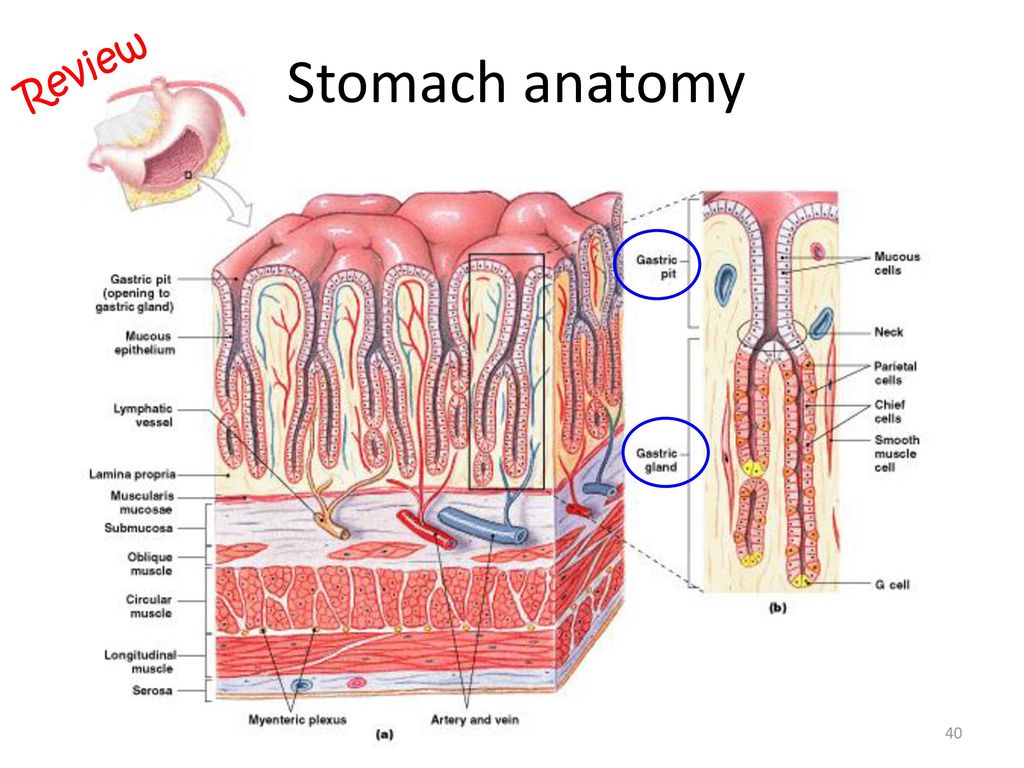 Diagnosis includes a special breath test to check for gaseous by-products of the bacteria. Treatment includes a combination of different antibiotics, followed by breath tests to make sure the medication has worked.
Diagnosis includes a special breath test to check for gaseous by-products of the bacteria. Treatment includes a combination of different antibiotics, followed by breath tests to make sure the medication has worked.
Where to get help
- Your doctor
- NURSE-ON-CALL Tel. 1300 60 60 24 – for expert health information and advice (24 hours, 7 days)
- Gastroenterologist
Things to remember
- Gastritis is inflammation (irritation) of the stomach lining.
- Common causes include infection, anti-inflammatory medication and alcohol.
- Treatment options include avoiding exposure to known irritants, and medication to reduce the amount of gastric juices.
- The Centre for Digestive DiseasesExternal Link, Sydney, Australia.
- Urea breath test [patient information online], The Centre for Digestive Diseases, Sydney, Australia. More information hereExternal Link.
This page has been produced in consultation with and approved
by:
Gastritis of the stomach: symptoms, signs and treatment
Gastritis is a general term that combines several pathological conditions characterized by inflammation and degeneration of the gastric mucosa.
The mucous membrane covers the entire surface of the stomach and plays an important role in digestion. Its glands produce gastric juice, the enzyme pepsin, hydrochloric acid, lipase, hormone-like components, mucus and bicarbonate. These substances are responsible for the breakdown of proteins and fats, protect the body from pathogenic bacteria, and activate metabolic processes.
When inflamed, the mucosa produces less acid, enzymes, mucus and other substances that are necessary for the proper functioning of the digestive tract. There is a risk of developing gastritis.
Gastritis can occur in acute and chronic form. It is important to consult a doctor in time to get a diagnosis and treatment, to prevent complications.
Forms and complications of gastritis
In the absence of adequate and timely treatment, gastritis can cause complications. These include:
- Gastric ulcer. Peptic ulcers affecting the lining of the stomach or duodenum.
 Peptic ulcer provokes excessive use of painkillers (NSAIDs), and gastritis caused by H. pylori. It is difficult to say where gastritis ends, especially with erosives, and peptic ulcer begins. Apparently, these are different forms of the same process.
Peptic ulcer provokes excessive use of painkillers (NSAIDs), and gastritis caused by H. pylori. It is difficult to say where gastritis ends, especially with erosives, and peptic ulcer begins. Apparently, these are different forms of the same process. - Atrophy of the gastric mucosa – atrophic gastritis. Occurs due to thinning of the mucosa, the formation of fibrosis (microscars) of the membrane in chronic gastritis. With atrophy, the number of active cells of the gastric mucosa that produce enzymes and acid decreases. The absorption of certain vitamins is impaired. Atrophic gastritis is a risk factor for oncological transformation, therefore it requires special attention.
- Gastric bleeding in erosive gastritis and ulcers. It is characterized by irregular breathing, weakness, dizziness, blood in the vomit and stool, black stools, pallor of the skin. If these symptoms appear, you should immediately seek medical help.
- Anemia. Most often occurs due to acute (as described above) or chronic blood loss, for example, with multiple recurring erosions of the stomach.
 Studies show that H. pylori-associated gastritis and autoimmune gastritis can interfere with the body’s absorption of iron and vitamin B12 from food, which can also cause anemia.
Studies show that H. pylori-associated gastritis and autoimmune gastritis can interfere with the body’s absorption of iron and vitamin B12 from food, which can also cause anemia. - Vitamin B12 deficiency and pernicious anemia (pernicious anemia). In autoimmune gastritis, a certain protein is not produced that helps absorb vitamin B12, which is necessary for the production of red blood cells and nerve cells. Insufficient absorption of vitamin B12 can lead to the development of pernicious anemia. The same changes occur in the advanced stage of atrophic gastritis of any origin.
- Cancer of the stomach. Chronic gastritis increases the likelihood of developing benign or malignant neoplasms in the gastric mucosa. For example, H. pylori-associated gastritis increases the risk of gastric mucosal adenocarcinoma and lymphoma.
Causes and risk factors of gastritis
- Helicobacter pylori bacterial infection. It is one of the most common types of infections, the infection is transmitted by the fecal-oral route, for example, through contaminated food and water.
 For the development of gastritis, the presence of Helicobacter pylori infection alone is not enough. It is believed that vulnerability to bacteria is inherited or occurs due to improper lifestyle (smoking, poor diet), medications.
For the development of gastritis, the presence of Helicobacter pylori infection alone is not enough. It is believed that vulnerability to bacteria is inherited or occurs due to improper lifestyle (smoking, poor diet), medications. - Pain medications (non-steroidal anti-inflammatory drugs, NSAIDs). Regular and excessive use of aspirin, ibuprofen or naproxen can cause both acute and chronic gastritis, their toxic effects reduce the production of the main protectors of the gastric mucosa. To distinguish this situation from other types of gastritis, it is called NSAID gastropathy.
- Alcohol. Irritates and gradually destroys the gastric mucosa, exposing it to the aggressive effects of gastric juice. Alcohol most often provokes acute gastritis.
- Age. Older people have an increased risk of developing gastritis, as the lining of the stomach thins with age. The elderly are also most vulnerable to infections (H. pylori) or autoimmune disorders.
- Stress. Severe stress associated with injuries, burns, major operations and infections can trigger acute gastritis.

- Exposure to radiation or radiotherapy (due to another medical condition).
- Bile reflux after gastric resection.
- Food allergies such as cow’s milk and soy (especially in children).
- Autoimmune diseases. As a result of autoimmune processes in the body, antibodies are produced that attack the cells that form the lining of the stomach. Autoimmune inflammation occurs, the functions of the protective mucosal barrier decrease. Gastritis associated with autoimmune disorders is called autoimmune gastritis. It is more common in people with other autoimmune disorders, including Hashimoto’s disease and type 1 diabetes. Autoimmune gastritis can also be associated with vitamin B12 deficiency.
- Other diseases. The risk of gastritis may be increased by other pathological conditions, including Crohn’s disease, sarcoidosis, parasitic infections, HIV/AIDS.
Symptoms of gastritis
- Heaviness in the stomach
- Heartburn
- Bloating
- Nausea
- Vomiting
These symptoms may appear or worsen during or shortly after eating. But most often gastritis is asymptomatic.
But most often gastritis is asymptomatic.
Sometimes the term “gastritis” is erroneously used to describe any symptoms of pain or discomfort in the upper abdomen, in most cases it is a manifestation of functional dyspepsia.
Stages of gastritis
- Hyperemia. At the first stage of development of gastritis, hyperemia (redness) of the gastric mucosa is observed. This is a protective vegetovascular reaction – vasodilation and increased blood flow in response to a negative effect on the mucosa. Hyperemia is accompanied by edema, this is a sign of the development of inflammation.
- Chronic inflammation, metaplasia, dysplasia. The production of hydrochloric acid decreases, the mucous membrane thickens. Hypertrophy is characteristic of people who abuse alcohol. Inflammation is characterized by the accumulation of leukocytes in the wall of the stomach, prolonged inflammation can change the structure of the stomach epithelium, it can become similar to intestinal, this phenomenon is called metaplasia and may be associated with an increase in cancer risk.
 But the risk is especially high if a biopsy reveals a violation of the structure of the tissue and cells of the stomach – dysplasia.
But the risk is especially high if a biopsy reveals a violation of the structure of the tissue and cells of the stomach – dysplasia. - Atrophy. Prolonged inflammation causes thinning of the gastric mucosa, recovery processes slow down, atrophic changes in the mucosa are observed – epithelial cells die and are replaced by scar tissue.
- Erosions and ulcers are a frequent companion of gastritis. Focal and deep changes develop due to a decrease in the efficiency of the mucous glands, thinning of the protective layer, in most cases this is a consequence of exposure to H. pylori.
Treatment of gastritis
Treatment for gastritis depends on the cause. Acute gastritis caused by NSAIDs or alcohol abuse does not require drug therapy, it is enough to exclude these triggers.
In other cases, the doctor may recommend:
- Antibiotic therapy against H. pylori.
- Drugs that block the production of hydrochloric acid (a component of gastric juice) and promote mucosal healing (proton pump inhibitors * – omeprazole, lansoprazole, rabeprazole, esomeprazole, dexlansoprazole, pantoprazole.

- Antacids** (neutralize stomach acid, relieve pain).
* – Long-term use of proton pump inhibitors, especially at high doses, may increase the risk of hip, wrist and spine fractures, may require an osteoporosis prevention program .
** – Side effects – constipation, diarrhea.
Features and benefits of gastritis treatment at Rassvet Clinic
Diagnosis and treatment of gastritis in the Rassvet clinic is carried out in the department of gastroenterology. We use evidence-based methods based on international clinical guidelines. Your main treatment will only begin after a physical examination and all necessary tests and diagnostic tests.
Important. The effect of certain foods or diets on the risk of gastritis has not been proven by studies.
At the Rassvet clinic, we first of all distinguish gastritis from functional dyspepsia. Gastritis is often asymptomatic, but it needs to be treated as it is a slow but sure road to stomach cancer.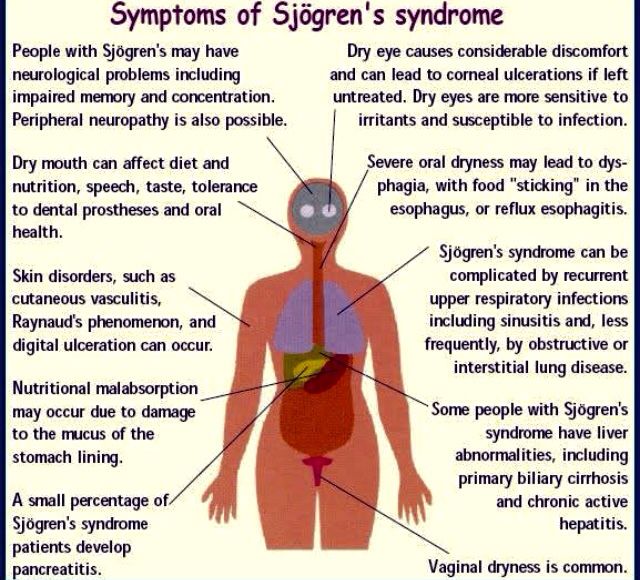 Functional dyspepsia, on the contrary, is accompanied by many complaints, but endoscopic examination and biopsy do not reveal any pathology.
Functional dyspepsia, on the contrary, is accompanied by many complaints, but endoscopic examination and biopsy do not reveal any pathology.
How gastritis is treated at Rassvet Clinic
To clarify the diagnosis, we use the most modern and accurate equipment and logistical methods. For example, we have built a system for diagnosing gastritis and determining oncological risk according to the OLGA classification. Our endoscopes allow you to perform gastroscopy with multiple magnification and examine the mucosa through light filters, take a biopsy from the most suspicious areas. The biopsy specimens themselves are also evaluated by the histologist according to the OLGA scale, and as a result we get a figure that reflects the risk of oncological transformation in the coming years. Further treatment tactics depend on the value of this figure.
We value the comfort of patients, so in Rassvet you can undergo an examination under anesthesia and in the shortest possible time.
Recommendations of a gastroenterologist at the Rassvet clinic for patients with gastritis
Timely access to a doctor and proper treatment will help keep the disease under control. You don’t need a strict diet. However, the rules of a healthy diet should be observed – do not overeat, avoid foods that irritate the mucous membrane (smoked, fried, fatty), give up alcohol. If you are forced to take painkillers that increase the risk of gastritis, ask if they can be replaced with a drug that is less aggressive to the gastric mucosa (acetaminophen, paracetamol).
Author:
Amelicheva Alena Aleksandrovna
medical editor
Publication date: June 17, 2019
Update date: August 10, 2022
Diseases of the oral cavity and gastrointestinal tract
Diseases of the gastrointestinal tract have a complex effect on the health of the entire digestive apparatus, which includes the oral cavity. First of all, this effect is due to a lack of vitamins and minerals, which leads to inflammatory processes, and in addition, it exacerbates existing diseases of the oral cavity.
Of course, in such cases, the treatment of the problem should be comprehensive – you need to contact both the dentist , who will eliminate the manifestations of diseases in the mouth, and the endocrinologist, who will directly eliminate the root of the disease itself.
Let us analyze the main examples of gastrointestinal diseases that directly affect the condition of the oral cavity and teeth.
Gastritis (gastroduodenitis)
This is one of the most common pathologies of the gastrointestinal tract, often found in both adults and children. With gastritis, due to changes in secretion, the acidity of gastric juice increases, and since all organs of the digestive system are directly interconnected, such acidity cannot but affect the health of the oral cavity.
Among the dental symptoms of this disease are pallor and swelling of the mucous membranes, hypertrophy of the papillae of the tongue, dry lips, gingivitis, bad breath and sour taste.
In chronic gastroduodenitis, mild forms of stomatitis, gingivitis , herpes on the lips are characteristic.
In both cases, saliva production is disturbed, which most directly affects the acid-base balance of the oral cavity and the intensity of bacterial reproduction: with a lack of saliva, the risk of carious and periodontal diseases .
Treatment: usually individual, aimed at normalizing gastric secretion, increasing the protective properties of the gastric mucosa and oral cavity. Dental treatment may include a course of antibiotics (as recommended by a physician), treatment of gingivitis and caries , enhanced oral hygiene using special toothpastes to strengthen the gums, and professional oral hygiene , carried out at least once every six months.
Gastric ulcer
The symptoms of the disease and its nature, in general, are similar to the symptoms of gastritis, but its manifestations are more vivid and persistent. Standard pathologies of the gastrointestinal tract can pass into a stomach ulcer with increased stress, frequent and unreasonable medications, alcohol and tobacco abuse, or with a genetic predisposition.
Standard pathologies of the gastrointestinal tract can pass into a stomach ulcer with increased stress, frequent and unreasonable medications, alcohol and tobacco abuse, or with a genetic predisposition.
Dental symptoms – swelling of the tongue, plaque on the oral mucosa, increased and increased sensitivity of the papillae of the tongue, fever in the mouth, gingivitis and stomatitis .
Treatment: similar to chronic gastritis or gastroduodenitis.
Cholecystitis
A disease caused by violations of the outflow of bile and anomalies of the gallbladder as a result of a deterioration in immunity and infectious diseases. An increase in infection activity in this case is also observed in the oral cavity.
Such bacterial diseases are fraught with an increased intensity of dental caries, both milk and indigenous, a high risk of rapid tooth decay. In addition, cases of gingivitis and stomatitis are increasing, as in the disease examples above.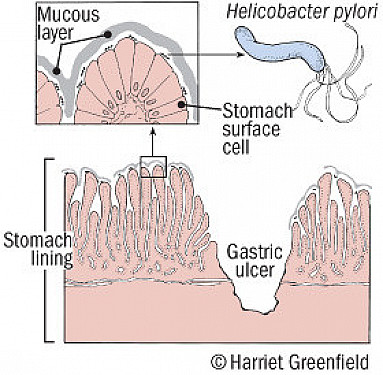

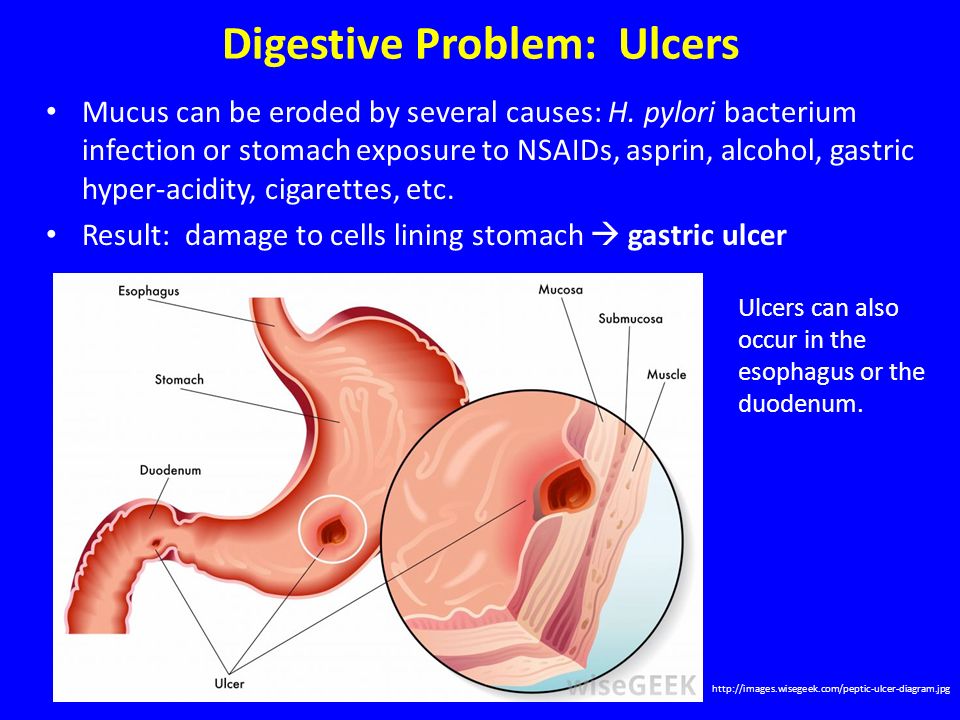 pylori.
pylori. This test looks at the lining of your food pipe (esophagus), stomach, and duodenum (the first part of your small intestine). It uses a thin, lighted tube or endoscope. The tube has a camera at one end. The tube is put into your mouth and throat. Then it goes down into your esophagus, stomach, and duodenum. Your healthcare provider can see the inside of these organs. A small tissue sample (biopsy) is taken if needed. The tissue sample can show if you have the enzyme urease. It can also check the bacteria that is there.
This test looks at the lining of your food pipe (esophagus), stomach, and duodenum (the first part of your small intestine). It uses a thin, lighted tube or endoscope. The tube has a camera at one end. The tube is put into your mouth and throat. Then it goes down into your esophagus, stomach, and duodenum. Your healthcare provider can see the inside of these organs. A small tissue sample (biopsy) is taken if needed. The tissue sample can show if you have the enzyme urease. It can also check the bacteria that is there. It may also be passed by direct contact with vomit or stool.
It may also be passed by direct contact with vomit or stool.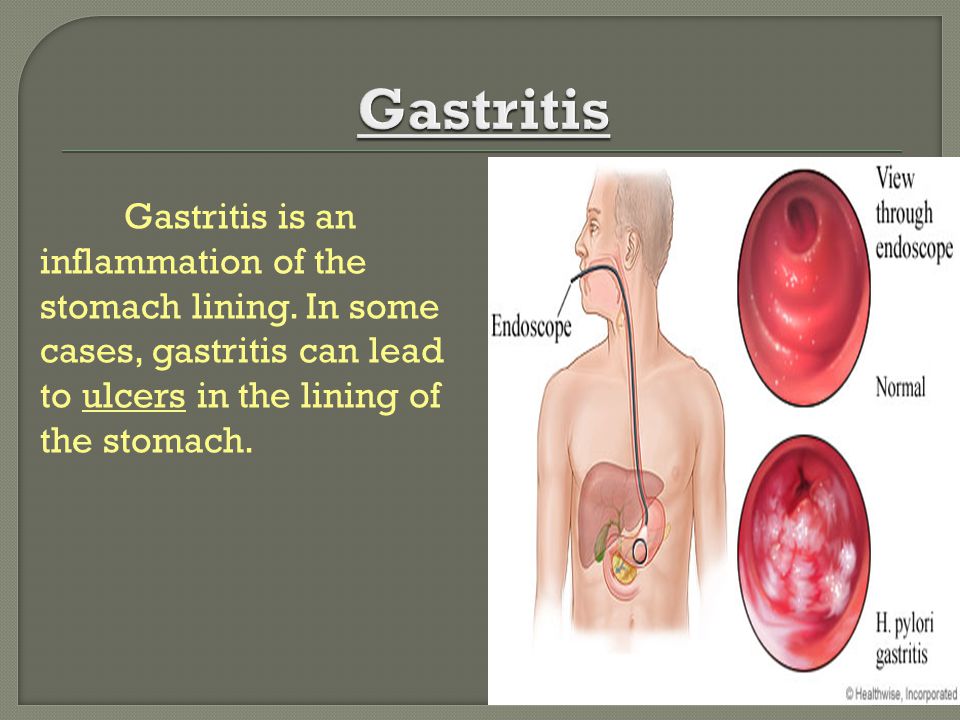

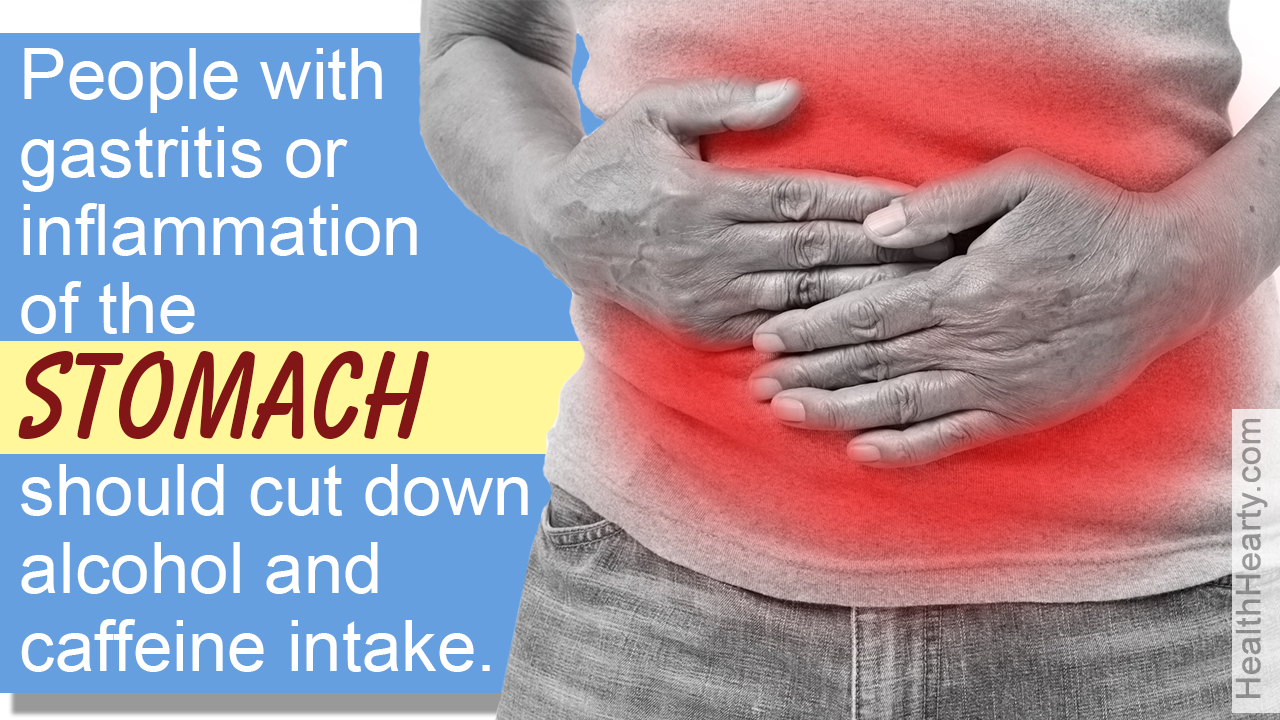

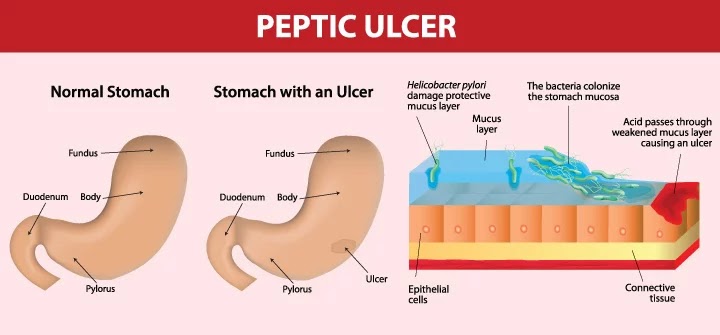
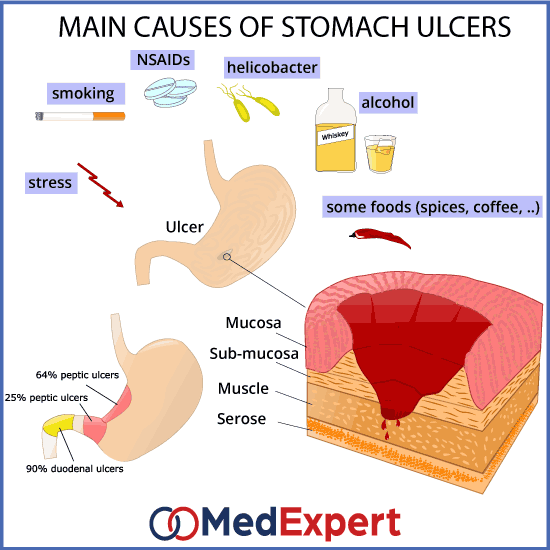 Peptic ulcer provokes excessive use of painkillers (NSAIDs), and gastritis caused by H. pylori. It is difficult to say where gastritis ends, especially with erosives, and peptic ulcer begins. Apparently, these are different forms of the same process.
Peptic ulcer provokes excessive use of painkillers (NSAIDs), and gastritis caused by H. pylori. It is difficult to say where gastritis ends, especially with erosives, and peptic ulcer begins. Apparently, these are different forms of the same process.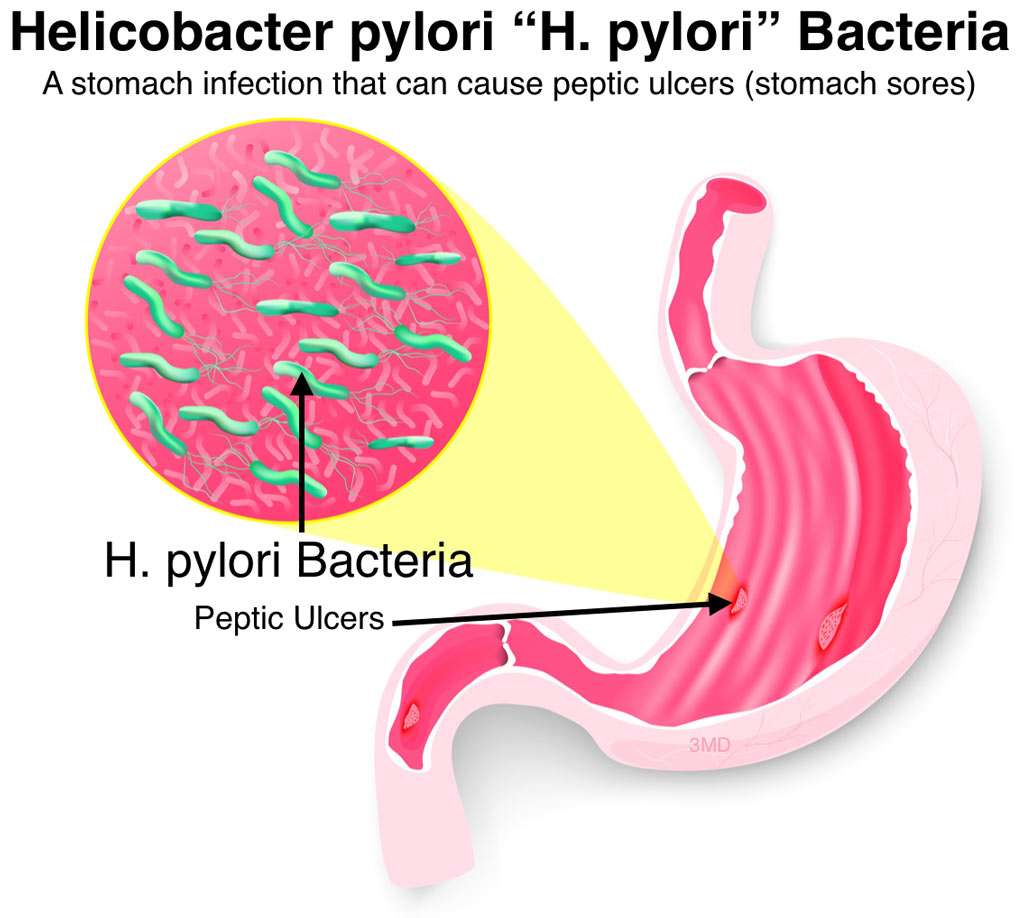 Studies show that H. pylori-associated gastritis and autoimmune gastritis can interfere with the body’s absorption of iron and vitamin B12 from food, which can also cause anemia.
Studies show that H. pylori-associated gastritis and autoimmune gastritis can interfere with the body’s absorption of iron and vitamin B12 from food, which can also cause anemia. For the development of gastritis, the presence of Helicobacter pylori infection alone is not enough. It is believed that vulnerability to bacteria is inherited or occurs due to improper lifestyle (smoking, poor diet), medications.
For the development of gastritis, the presence of Helicobacter pylori infection alone is not enough. It is believed that vulnerability to bacteria is inherited or occurs due to improper lifestyle (smoking, poor diet), medications.
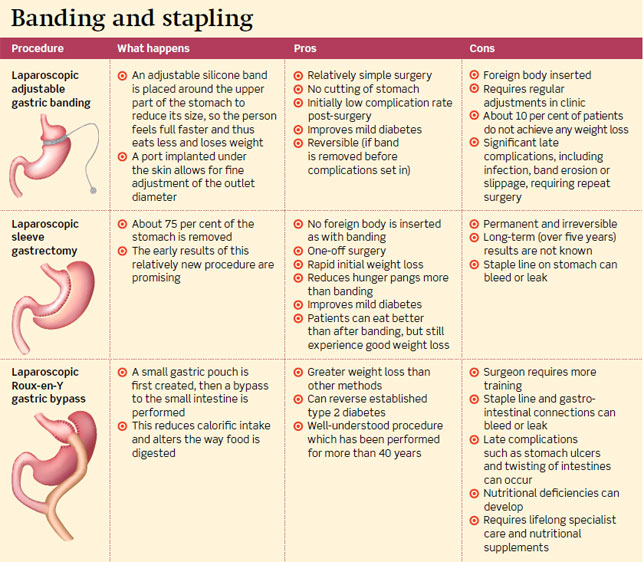 But the risk is especially high if a biopsy reveals a violation of the structure of the tissue and cells of the stomach – dysplasia.
But the risk is especially high if a biopsy reveals a violation of the structure of the tissue and cells of the stomach – dysplasia.
